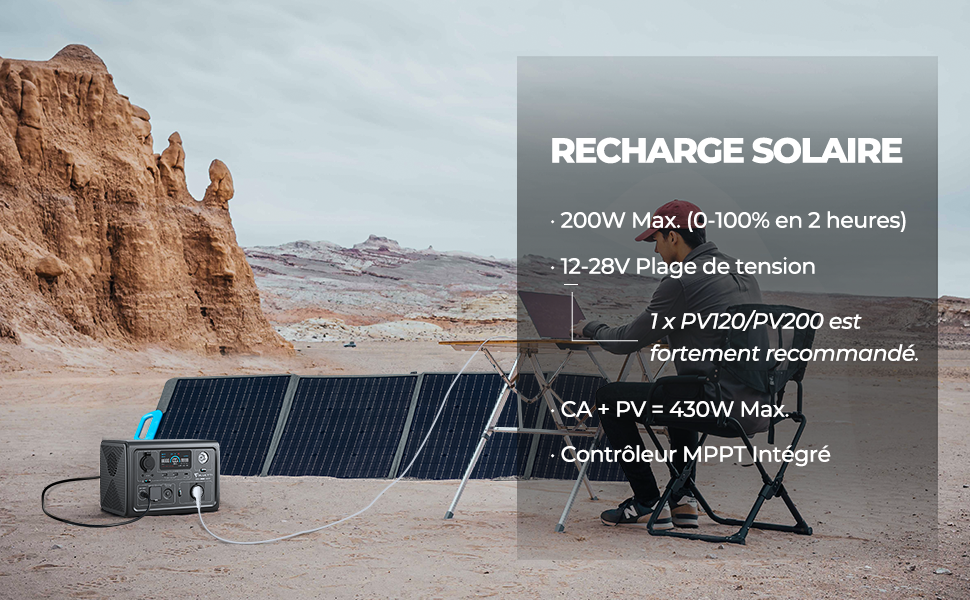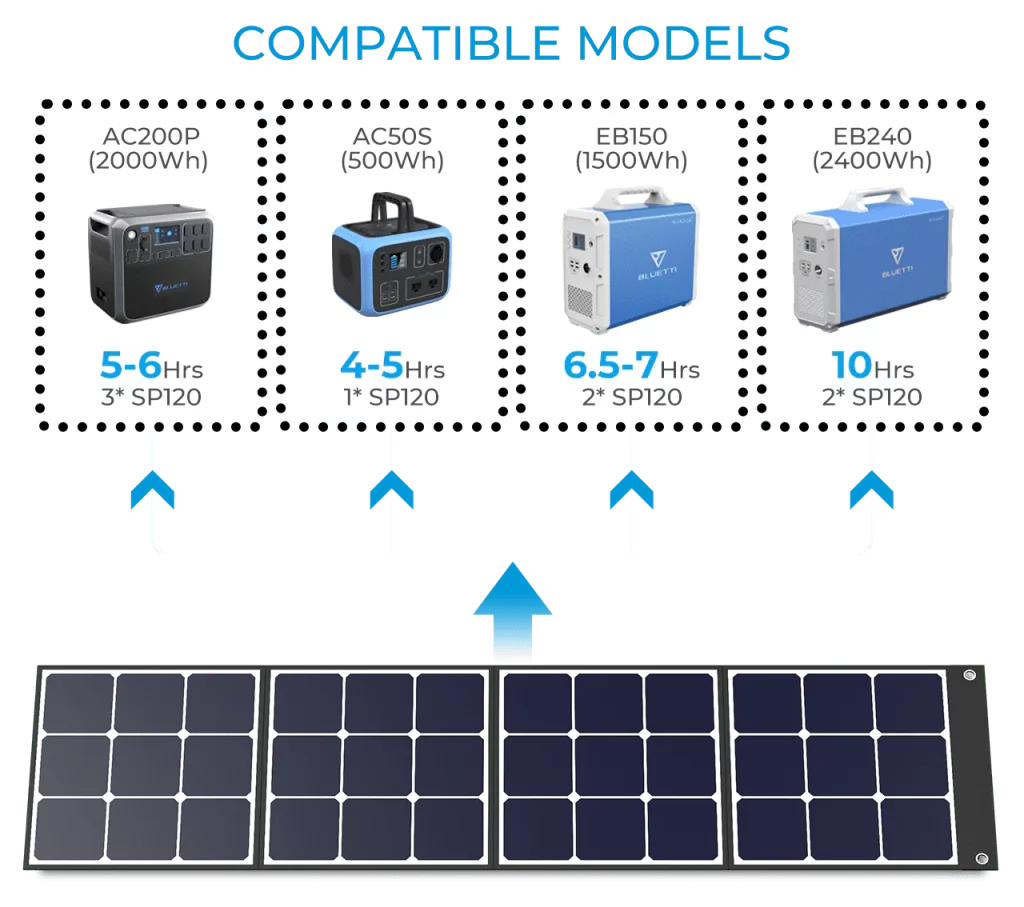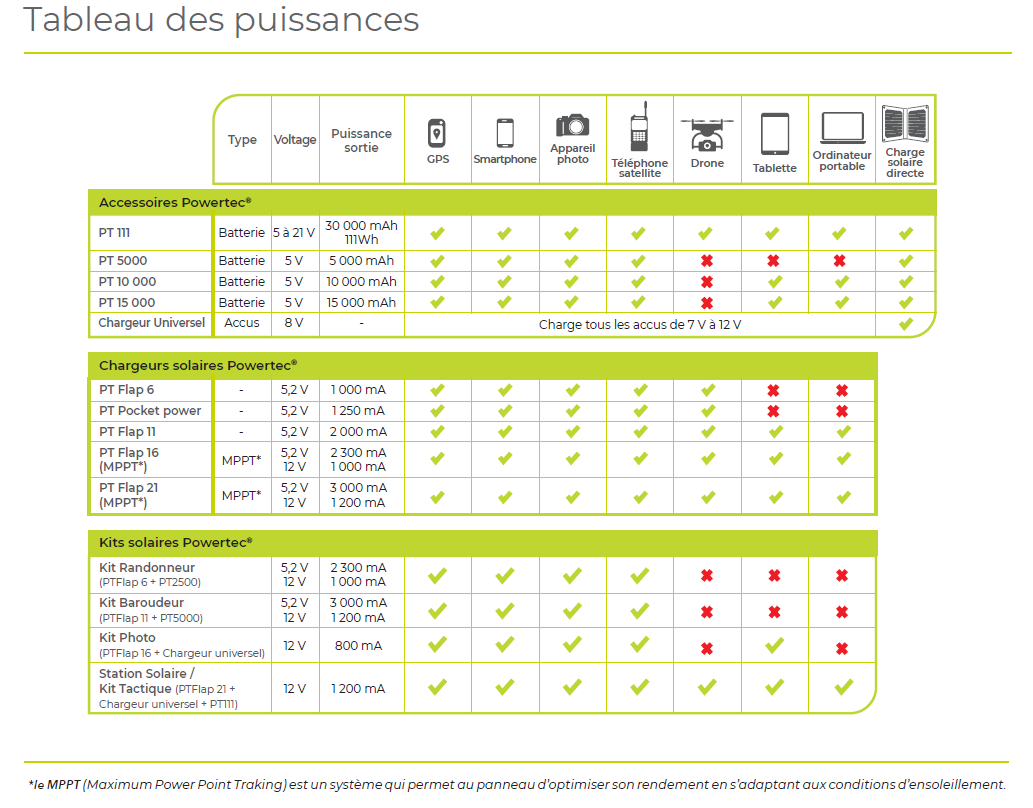At a time when the energy transition is more necessary than ever, the solar generator is a relevant and promising solution. These devices offer a renewable and sustainable source of energy, while maximising energy autonomy.
What is a solar generator?
It’s a device that converts solar energy into electricity, using solar panels and an energy storage system. It’s a clean, renewable solution that can be used to power homes, industrial facilities or even remote areas with no access to the electricity grid. 
The benefits
There are many advantages to solar generators. They reduce CO2 emissions, offer energy autonomy and are cost-effective in the long term. What’s more, they are silent and require little maintenance, unlike traditional generators that run on fossil fuels.
How a solar generator works
The operation of a solar generator is relatively simple. Solar panels capture sunlight and convert it into electricity. This energy is then stored in batteries for continuous use, even when the sun is not shining.  Calculating the profitability of a solar generator set The initial cost of a solar generator may be high, but its long-term use makes it profitable. For example, for a 5kW generator, the average cost is around €15,000. Assuming a lifespan of 20 years and average use, the savings in electricity bills can be as much as €30,000. The future of solar generators The future of solar generators is bright. According to a study by Global Market Insights, the solar generator market could reach $1.5 billion by 2026, with an annual growth rate of over 7%.
Calculating the profitability of a solar generator set The initial cost of a solar generator may be high, but its long-term use makes it profitable. For example, for a 5kW generator, the average cost is around €15,000. Assuming a lifespan of 20 years and average use, the savings in electricity bills can be as much as €30,000. The future of solar generators The future of solar generators is bright. According to a study by Global Market Insights, the solar generator market could reach $1.5 billion by 2026, with an annual growth rate of over 7%.
Conclusion
The solar generator is undoubtedly a major innovation in the field of renewable energy. Its potential for reducing carbon emissions, energy autonomy and cost-effectiveness puts it at the heart of tomorrow’s energy transition.
FAQ: How does a solar generator work?
A solar generator is a device that combines solar panels, an inverter and an energy storage system, usually in the form of batteries. It works in several main stages: Collecting solar energy: Solar panels, made up of photovoltaic cells, capture the sun’s energy. These cells contain semi-conductors which, when exposed to sunlight, produce a direct current (DC). Energy conversion: The direct current generated by solar panels is not directly usable in our domestic appliances, which generally operate on alternating current (AC). This is where the inverter comes in, converting the direct current into alternating current. Energy storage Not all the electricity produced by the solar panels is used immediately. Surplus electricity is stored in the generator’s battery system. This storage allows the solar electricity produced during the day to be used to power electrical appliances at night or on cloudy days. Energy use: The electricity stored in the batteries, or that generated directly by the solar panels (if consumed during sunny hours), is used to power the electrical appliances connected to the system.
Enhancing the Efficiency of Solar Generators
To maximize the efficiency and benefits of solar generators, advancements in technology and strategic implementation play crucial roles. One significant advancement is the development of high-efficiency solar panels. These panels are capable of converting more sunlight into electricity, thus increasing the overall output of the generator. For instance, while traditional solar panels might convert around 15-18% of sunlight into electricity, newer models can achieve conversion rates of over 20%. This means more energy can be harvested from the same amount of sunlight, making the solar generator more effective, especially in areas with limited sunlight exposure.
Moreover, integrating smart technology with solar generators can significantly enhance their efficiency. Smart solar generators can use energy management systems to optimize the use and storage of electricity. These systems monitor energy production, storage levels, and usage patterns, automatically adjusting to ensure that energy is used in the most efficient way possible. For example, during peak sunlight hours, the system can prioritize charging the batteries while supplying power to essential devices, and during off-peak hours, it can manage the distribution of stored energy based on real-time demand. This not only maximizes the use of solar energy but also extends the lifespan of the batteries by preventing overcharging and deep discharging.
Applications and Future Trends in Solar Generators
Solar generators are increasingly being adopted in a variety of applications, from residential to commercial and industrial uses. In residential settings, they provide a reliable backup power source, reducing dependence on the grid and ensuring energy security during outages. For off-grid living, they are indispensable, offering a sustainable and continuous power supply for daily needs. In commercial and industrial sectors, solar generators can significantly reduce operational costs and carbon footprints by supplying renewable energy for machinery, lighting, and other equipment.
The future of solar generators is promising, with ongoing research and development driving innovations that will make these systems even more efficient and accessible. One such trend is the integration of solar generators with smart grids and the Internet of Things (IoT). This integration allows for better energy management and optimization at a larger scale, facilitating the distribution of surplus energy to the grid or other users. Additionally, advancements in battery technology, such as the development of solid-state batteries and improvements in lithium-ion and lithium-iron-phosphate (LiFePO4) batteries, are set to enhance the storage capacity and longevity of solar generators.
Another exciting trend is the increasing affordability and scalability of solar generators. As production costs decrease and technology improves, solar generators are becoming more affordable for a broader range of users. This democratization of renewable energy technology means that more households and businesses can invest in solar generators, contributing to a larger-scale energy transition. Furthermore, the modular design of many modern solar generators allows users to start with a basic setup and expand their system over time as their energy needs and budget allow.
Conclusion
Solar generators represent a pivotal innovation in the transition to renewable energy. Their ability to convert and store solar energy efficiently, combined with their environmental and economic benefits, positions them as a critical component in the future of sustainable energy solutions. With advancements in technology enhancing their efficiency and reducing costs, the adoption of solar generators is expected to grow significantly in the coming years. Whether for residential, commercial, or industrial applications, solar generators offer a reliable, eco-friendly, and cost-effective way to harness the power of the sun, paving the way for a greener and more sustainable future.
FAQ
- How does a solar generator work?
A solar generator is a device that combines solar panels, an inverter, and an energy storage system, usually in the form of batteries. It works in several main stages:
- Collecting solar energy: Solar panels, made up of photovoltaic cells, capture the sun’s energy. These cells contain semiconductors which, when exposed to sunlight, produce a direct current (DC).
- Energy conversion: The direct current generated by solar panels is not directly usable in our domestic appliances, which generally operate on alternating current (AC). This is where the inverter comes in, converting the direct current into alternating current.
- Energy storage: Not all the electricity produced by the solar panels is used immediately. Surplus electricity is stored in the generator’s battery system. This storage allows the solar electricity produced during the day to be used to power electrical appliances at night or on cloudy days.
- Energy use: The electricity stored in the batteries, or that generated directly by the solar panels (if consumed during sunny hours), is used to power the electrical appliances connected to the system.
- What are the benefits of solar generators?
Solar generators offer numerous benefits, including reducing CO2 emissions, providing energy autonomy, and being cost-effective in the long term. They are silent and require little maintenance, unlike traditional generators that run on fossil fuels. Furthermore, solar generators can be used in remote areas without access to the electricity grid, enhancing energy security and independence.
- Are solar generators expensive to maintain?
Solar generators require minimal maintenance compared to traditional fossil fuel generators. Regular checks and occasional cleaning of the solar panels to ensure they are free from dust and debris are usually sufficient. The batteries will also need to be monitored and possibly replaced after a number of years, depending on their type and usage patterns. However, the overall maintenance costs are relatively low, especially considering the savings on electricity bills and the environmental benefits.
- Can solar generators be used in any location?
Solar generators can be used in a variety of locations, but their efficiency depends on the amount of sunlight available. They are most effective in areas with high solar irradiance. However, advancements in solar technology and energy storage systems mean that they can still provide significant benefits even in less sunny regions. Portable and modular solar generators can also be used in remote or off-grid locations, making them highly versatile.

 Calculating the profitability of a solar generator set The initial cost of a solar generator may be high, but its long-term use makes it profitable. For example, for a 5kW generator, the average cost is around €15,000. Assuming a lifespan of 20 years and average use, the savings in electricity bills can be as much as €30,000. The future of solar generators The future of solar generators is bright. According to a study by Global Market Insights, the solar generator market could reach $1.5 billion by 2026, with an annual growth rate of over 7%.
Calculating the profitability of a solar generator set The initial cost of a solar generator may be high, but its long-term use makes it profitable. For example, for a 5kW generator, the average cost is around €15,000. Assuming a lifespan of 20 years and average use, the savings in electricity bills can be as much as €30,000. The future of solar generators The future of solar generators is bright. According to a study by Global Market Insights, the solar generator market could reach $1.5 billion by 2026, with an annual growth rate of over 7%.
